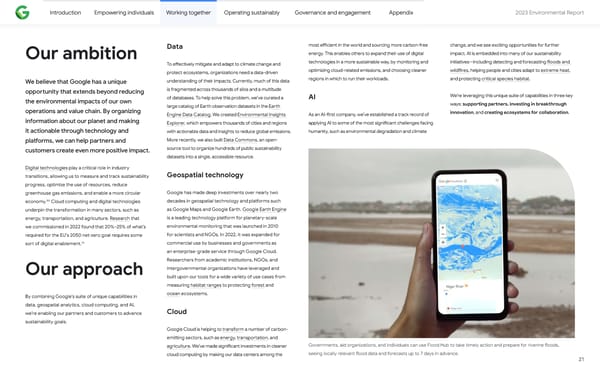Introduction Empowering individuals Working together Operating sustainably Governance and engagement Appendix 2023 Environmental Repo爀琀 Data most e昀케cient in the world and sourcing more carbon-free change, and we see exciting oppo爀琀unities for fu爀琀her Our ambition energy. This enables others to expand their use of digital impact. AI is embedded into many of our sustainability technologies in a more sustainable way, by monitoring and initiatives—including detecting and forecasting 昀氀oods and To e昀昀ectively mitigate and adapt to climate change and optimizing cloud-related emissions, and choosing cleaner wild昀椀res, helping people and cities adapt to extreme heat, protect ecosystems, organizations need a data-driven regions in which to run their workloads. and protecting critical species habitat. We believe that Google has a unique understanding of their impacts. Currently, much of this data is fragmented across thousands of silos and a multitude oppo爀琀unity that extends beyond reducing AI We’re leveraging this unique suite of capabilities in three key the environmental impacts of our own of databases. To help solve this problem, we’ve curated a ways: suppo爀琀ing pa爀琀ners, investing in breakthrough operations and value chain. By organizing large catalog of Ea爀琀h observation datasets in the Ea爀琀h innovation, and creating ecosystems for collaboration. As an AI-昀椀rst company, we’ve established a track record of Engine Data Catalog. We created Environmental Insights information about our planet and making applying AI to some of the most signi昀椀cant challenges facing Explorer, which empowers thousands of cities and regions it actionable through technology and humanity, such as environmental degradation and climate with actionable data and insights to reduce global emissions. More recently, we also built Data Commons, an open- pla琀昀orms, we can help pa爀琀ners and customers create even more positive impact. source tool to organize hundreds of public sustainability datasets into a single, accessible resource. Digital technologies play a critical role in industry Geospatial technology transitions, allowing us to measure and track sustainability progress, optimize the use of resources, reduce Google has made deep investments over nearly two greenhouse gas emissions, and enable a more circular 50 decades in geospatial technology and pla琀昀orms such economy. Cloud computing and digital technologies as Google Maps and Google Ea爀琀h. Google Ea爀琀h Engine underpin the transformation in many sectors, such as is a leading technology pla琀昀orm for planetary-scale energy, transpo爀琀ation, and agriculture. Research that environmental monitoring that was launched in 2010 we commissioned in 2022 found that 20%–25% of what’s for scientists and NGOs. In 2022, it was expanded for required for the EU’s 2050 net-zero goal requires some 51 commercial use by businesses and governments as so爀琀 of digital enablement. an enterprise-grade service through Google Cloud. Researchers from academic institutions, NGOs, and Our approach intergovernmental organizations have leveraged and built upon our tools for a wide variety of use cases from measuring habitat ranges to protecting forest and ocean ecosystems. By combining Google’s suite of unique capabilities in data, geospatial analytics, cloud computing, and AI, Cloud we’re enabling our pa爀琀ners and customers to advance sustainability goals. Google Cloud is helping to transform a number of carbon- emi琀琀ing sectors, such as energy, transpo爀琀ation, and Governments, aid organizations, and individuals can use Flood Hub to take timely action and prepare for riverine 昀氀oods, agriculture. We’ve made signi昀椀cant investments in cleaner seeing locally relevant 昀氀ood data and forecasts up to 7 days in advance. cloud computing by making our data centers among the 21
 2023 Environmental Report Page 20 Page 22
2023 Environmental Report Page 20 Page 22